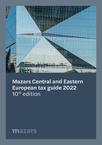
Mazars Central and Eastern European Tax Guide 2022
The guide represents offers up-to-date information on taxation in 22 European countries, including labor costs, corporate profit taxation, and transfer pricing. The guide serves long-term investment decisions by analyzing long-term taxation trends and fundamental changes in the tax regimes, both in comparison with each other and to previous years.
In addition to the Visegrad Group, the guide analyses the tax regimes of the South-Eastern European countries, Germany, Austria, Moldova, Ukraine, and the Baltic States, focusing on changes and trends in the tax regimes.
Key findings:
- The region's tax wedge remains relatively wide, ranging between 15 and 51%.
- Countries maintain a characteristically different approach to income taxation and tax relief for families with children.
- VAT remains the prime source of tax revenues in the listed countries; digital technologies have visibly improved the efficiency of tax collection. The standard VAT rate of Poland remains at the rate of 23 percent.
- There are still significant differences in the approach to corporate taxation in the region. Only one country reduced its corporate profit tax rate from last year.
- Digitization obligations are being introduced in Poland. Obligatory e-invoicing will probably enter into force in 2024.
- The average monthly wage in the private sector in 2021 in Poland was EUR 1280, whilst the real growth of the average wage in 2021 compared to 2020 was 3 percent.
We hope and trust that our readers will find this summary useful and inspiring. We also included the contact information for Mazars offices and experts.
Please visit the interactive online platform of the Mazars CEE Tax Guide 2022
Mazars CEE Tax Guide 2022 Online Tool
Want to know more?





















